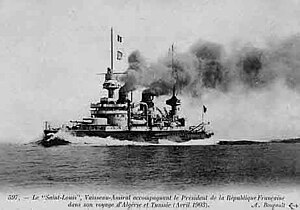French battleship St Louis

Saint Louis in April 1903
|
|
| History | |
|---|---|
|
|
|
| Name: | Saint Louis |
| Namesake: | King Louis IX of France |
| Builder: | Arsenal de Lorient |
| Cost: | 26,981,000 francs |
| Laid down: | 30 September 1893 |
| Launched: | 2 September 1896 |
| Commissioned: | 15 September 1900 |
| Decommissioned: | 8 February 1919 |
| Reclassified: |
|
| Struck: | 29 June 1931 |
| Fate: | Sold for scrap, 25 April 1933 |
| General characteristics | |
| Class and type: | Charlemagne-class battleship |
| Displacement: | 11,275 t (11,097 long tons) (deep load) |
| Length: | 117.7 m (386 ft 2 in) |
| Beam: | 20.3 m (66 ft 7 in) |
| Draught: | 8.4 m (27 ft 7 in) |
| Installed power: |
|
| Propulsion: | 3 shafts, 3 four-cylinder vertical triple-expansion steam engines |
| Speed: | 18 knots (33 km/h; 21 mph) |
| Range: | 4,200 miles (3,650 nmi) at 10 knots (19 km/h; 12 mph) |
| Complement: |
|
| Armament: |
|
| Armour: |
|
Saint Louis was the last of the three Charlemagne-class pre-dreadnought battleships built for the French Navy in the mid-1890s. She spent most of her career assigned to the Mediterranean Squadron (escadre de la Méditerranée) and usually was chosen to serve as a flagship. The ship was involved in two accidental ramming incidents with two other French warships in her career, one of which sank a submarine.
When World War I began, she escorted Allied troop convoys for the first two months. Saint Louis was ordered to the Dardanelles in November 1914 to guard against a sortie into the Mediterranean by the German battlecruiser SMS Goeben. In 1915, she was transferred to the Eastern Mediterranean where she participated in bombarding Turkish positions in Palestine and the Sinai Peninsula. The ship returned to the Dardanelles in May and provided fire support during the Gallipoli Campaign. Saint Louis was transferred to the squadron assigned to prevent any interference by the Greeks with Allied operations on the Salonica front in May 1916, after a lengthy refit in France. The ship was placed in reserve in April 1917 and briefly became a training ship in 1919–20. She was converted to serve as an accommodation hulk in 1920 and listed for disposal as scrap in 1931. Saint Louis did not find a buyer, however, until 1933.
...
Wikipedia
